Welcome to the Janison Academy help portal
People
Organisations are the top-level structures for organising people in the CLS and are directly attached to the Tenant
Organisations are set up using a strict tree structure, a structure that is based on an upside-down, idealised tree:
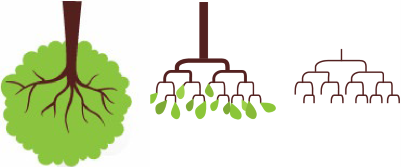
Consider the example of a tiny company with four separate sections:
To bring this company into the CLS we start with their HR diagram:

If we take this HR structure and translate it into the CLS Organisations model, the company would be the Organisation. From the Organisation there are several specific categories of people. In the CLS these categories are called Organisation Units and their staff are the CLS Users:
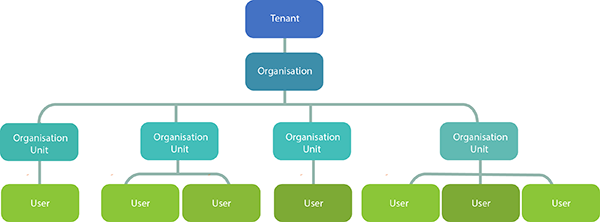
After merging these two hierarchies into the diagram below, we can see that the Organisation Units are now:

[The abbreviation Org Unit is used in the CLS for Organisation Unit].
As is clear, this strict tree structure models the HR structure of the company. Each person belongs to one and only one Org Unit. As is also clear in the diagram, the strict tree structure means that (working from the bottom to the top) a User can only belong to one Organisation Unit but s/he could be one of a number of Users that also belong to this Organisation Unit. And this Organisation Unit can only belong to one Organisation but it could be one of many Organisation Units that also belong to the Organisation.
This kind of strict tree structure is used in other parts of the CLS, for example with Position to Position reporting hierarchies, see Positions. Groups use a different, more flexible kind of tree structure. They can play an important role in the CLS by augmenting and/or bypassing the organisation structure above, see Organisations and Groups for a full description.
Overall, every CLS User is a member of one Organisation, one Organisation Unit and possibly one or more Groups. A User may also have a Position. Combining these functionalities makes it possible to model the HR structures of Health, Government, Education and Corporate organisations and to make it easier to manage and report on large numbers of Users.
Note also that most Users will not be able to see the Manage Organisations screens described here because the CLS Security management system uses scope-based Roles. This does not allow Users to see lists of items beyond the scope of their assigned Role. For example, someone who manages a particular organisation will not be able to see a list of all organisations. Organisations are the highest level (widest scoped) people structure in the CLS, thus only high-level administrators are able to see them.
[Tree image courtesy of cliparts.co]
In the Introduction to Organisations we saw that Organisation and Organisation Units are set up following a hierarchical structure known as a strict tree structure. Different kinds of more flexible hierarchical structures operate elsewhere in the CLS, such as with Groups. A User can belong to more than one Group and Groups are not necessarily tied to the Organisations structure.
Groups are collections of Users and Group Types are collections of Groups, see Groups for more information. Groups can play an important role in the CLS by augmenting and/or bypassing the structure provided by Organisations. Using Groups, cohorts of people can be specified that cross HR boundaries, such as a group of Organisation-wide fire wardens.
Another equally important role that Groups can play in the CLS is to augment the hierarchy provided by Organisations. Consider the situation where the tiny company described in the Introduction grows in size and complexity. For example, it now has two separate factories with their own management and production sections, which has introduced two new levels to the company’s original HR structure:
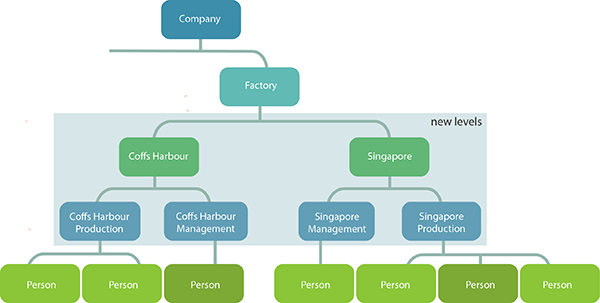
[The number of Users here is reduced for simplicity.]
In the CLS the Organisations structure is two levels deep. To match this new HR structure we need to have four levels of organisation. We can create Groups and Group Types to create the extra levels in the hierarchy.
In this example, Coffs Harbour could be a Group Type (in red) with Coffs Harbour Production and Coffs Harbour Management being Groups (in orange) that are members of this Group Type. Similarly Singapore would be a Group Type with Singapore Production and Singapore Management being Groups that are members of this Group Type. All four Groups contain Users, as shown below.

The diagram below shows part of the company’s original Organisations hierarchy, which was seen in the Introduction. The new Groups and Group Types hierarchy has been overlaid (in red and orange) on the Organisations hierarchy. The Groups are all linked to the Factory Org Unit. And all the factory staff in both locations are members of the same Factory Org Unit.

Thus a Group/Group Type hierarchy offers a way to address cohorts of staff within one Org Unit through Group memberships. For example all the Singapore factory staff – both production and management – could be targeted through the Singapore Group Type. These staff don’t belong to the Group Type but they do belong to Groups that are linked to it and hence could be located via the Group Type. And factory management staff in both locations could be targeted through the Coffs Harbour Management and Singapore Management Groups.
Thus, Groups can be used to add levels to an Organisations hierarchy or to create the cohorts of Users that bypass the Organisations hierarchy altogether. An example of the latter is a group of organisation-wide wardens described in more detail in Groups. It is important to understand that there is no one fixed way to manage multi-level HR structures in the CLS. Another approach to the situation above would be to create a new organisation structure with more than one Organisation in the Tenant. It all depends on what you want to be able to do with your cohorts of people and how you want to manage them. The CLS is flexible enough for you to design a configuration that best suits your organisation’s needs. You should discuss how to configure your implementation of the CLS with Janison and consider:
Organisations can be accessed by selecting Manage People > Organisations.
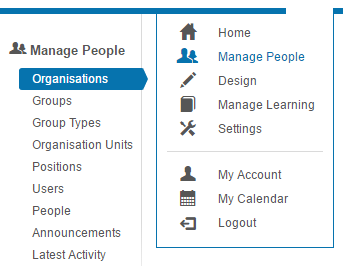
The screen shows a list of Organisations in the tenant.
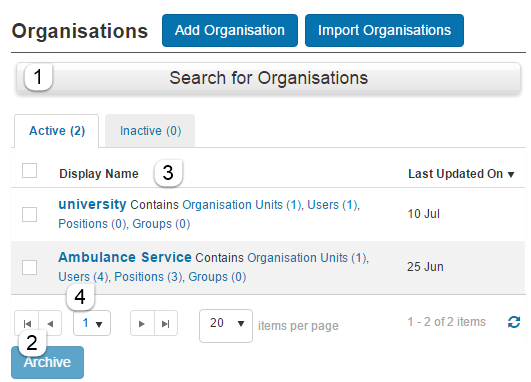
From this screen you can:
Each Organisation is listed, along with the number of Organisation Units, Users, Positions (if Position management is enabled) and Groups that are attached to it. Each of these items is itself a clickable link to further information about the list items and ultimately the opportunity to examine or edit members of the list. For example clicking Users attached to the Ambulance Service Organisation (4) leads to a list of those 4 Users with links that allow you to email, inspect or edit each User.
Note that you can reorder the list of Organisations by Display Name or Last Update by clicking on the appropriate column heading.
Inspecting an Organisation’s details shows you the Identifier and Title of the Organisation as well as the number of Organisation Units, Users, Positions (if Position management is enabled) and Groups that are attached to it. These are also links to lists of those entities.
To inspect an Organisation’s details navigate to Manage People > Organisations locate the Organisation and click its Name.
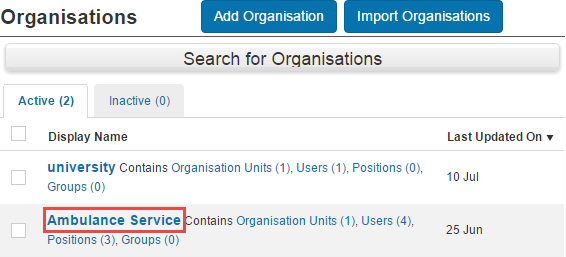
Inspect the details as desired.

You can also click Administrators to add Users with various Roles over the Organisation. For example, depending on how the Roles are set up, making a User as a Marker will give her/him access to Manage Learning > Marking where s/he can mark any Test Attempts that Users in this Organisation produce. Note that this Administrators widget allows authorised Users to add and remove administrators too.
Organisations can be added to the system manually or by importing a CSV file.
Note that Organisations support linking to Custom Attributes, which can be really useful for reporting purposes. Set up the Custom Attributes for the Organisations entity first, see Custom attributes, then enter values for them in the manual edit form or spreadsheet import.
Select Manage People > Organisations > Add Organisation.

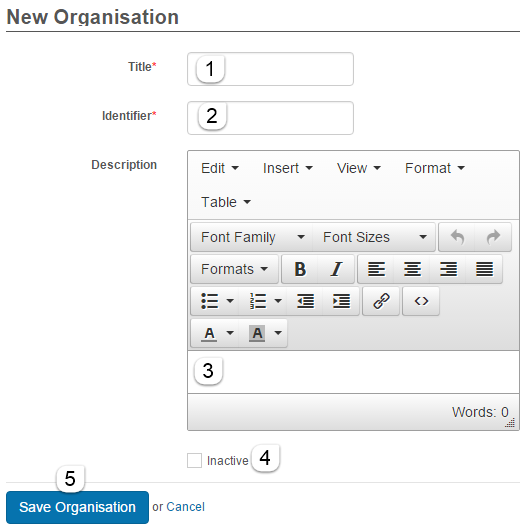
Select Manage People > Organisations > Import Organisations.


Enter all required data in the template and save to your local machine.
Note that there is a provision for the addition of values for Custom Attributes and these must exist in the system prior to the import. In the example above there must be custom attributes already in the system with identifiers PostCode and Address. If so, the importer will assign these custom attributes to the Organisation entity and they should be visible on the Organisation details screen.
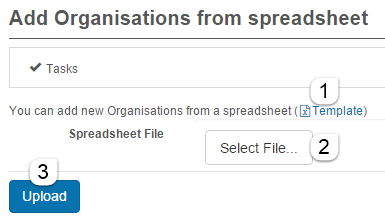
In addition to being created manually, new organisations can be imported from a CSV file (e.g. a Microsoft Excel spreadsheet). Any organisations that already exist in the system can also be updated via spreadsheet import. Janison Academy provides a template that you will need to download and populate with your organisation data before importing it.
Important things to note when editing the file
Custom attributes may be included in the upload. The template includes example Custom Attribute String columns. In order to be able to import custom attribute values during an organisation import:
If you attempt to upload an organisations import spreadsheet with custom attributes that do not already exist in the system, or are not linked to the organisation entity, an error message will display. Delete any unneeded custom attribute columns from the spreadsheet to avoid errors.

In this example organisations import spreadsheet, custom attributes with identifiers Postcode and Address must already be linked to the organisation object in the system. Once linked, the custom attribute will be visible on the Add Organisation and Edit Organisation screens and values for the custom attributes can be added or imported. See the help section on custom attributes for more information.
Open the template file downloaded from the Add Organisations from spreadsheet screen, populate it with the required data, and save the file to your local machine or network storage device. You may want to give the file a new name when saving.
Any details contained in the spreadsheet for an existing organisation will overwrite the details in the system.
The Search feature allows you to quickly find an Organisation. Search is only required when there are a large number of Organisations in the list.
To search for an Organisation select Manage People > Organisations.
The search results will appear in the Display Name column.
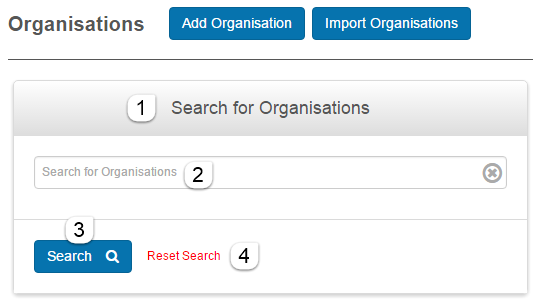
The Organisation Edit form allows administrators to modify the Organisation’s details.
Follow the steps to inspect the Organisation and then click Edit Organisation.
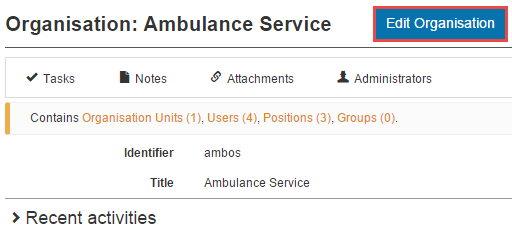
Change the details as required and click Save Organisation.
Organisations should be archived rather than deleted. There are two ways to archive an organisation:


Select Manage People > Organisations.
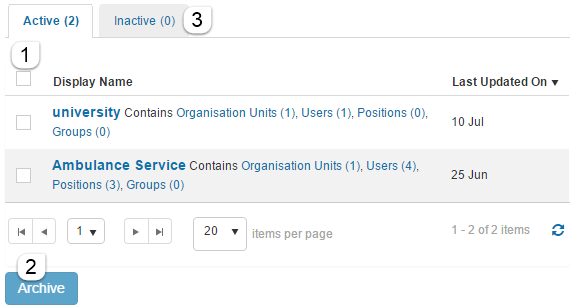
1300 857 687 (Australia)
+61 2 6652 9850 (International)
ACN 091 302 975
ABN 35 081 897 494
© 2024 Janison
Janison acknowledges the traditional owners of the land on which we work and meet. We acknowledge the continuous care of the land, animals and waterways. We pay our respects to Elders past, present and emerging.